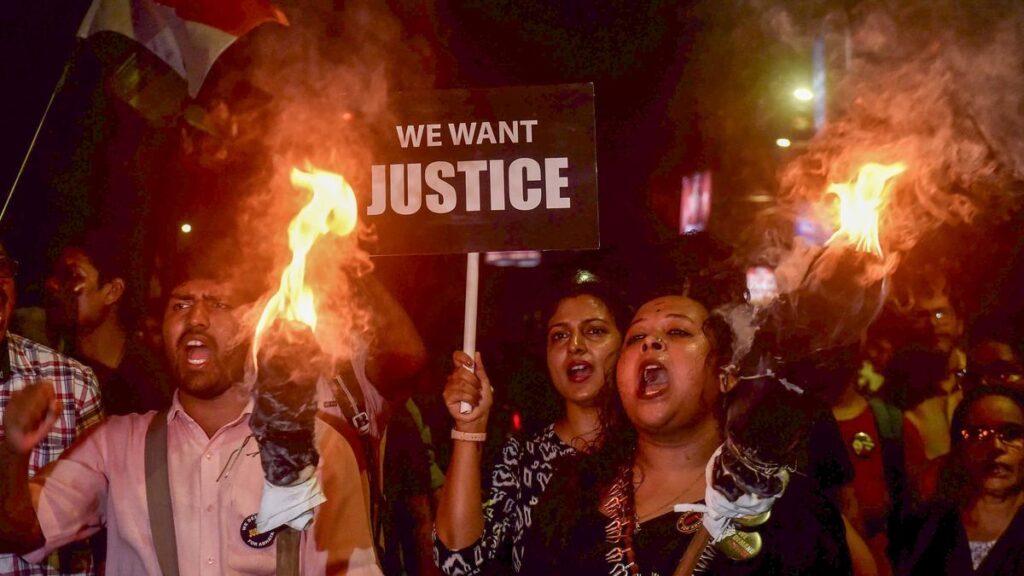
Junior doctors raise slogans during a torch rally towards the CBI office in protest against the alleged rape and murder of a woman medic at the R.G. Kar Medical College and Hospital, in Kolkata, on October 30, 2024.
| Photo Credit: PTI
The story so far: On January 22, two separate murder convictions resulted in sharply contrasting verdicts, highlighting how the Indian courts apply the death penalty. While one case led to capital punishment, the other saw the accused sentenced to life imprisonment, reigniting questions about the judiciary’s approach to the ‘rarest of rare’ doctrine, which till now does not have a statutory definition.
What were the cases?
On August 9, 2024, a second-year female postgraduate trainee doctor, who was on duty, was raped and murdered inside a seminar room at Kolkata’s R.G. Kar Medical College and Hospital. Sanjay Roy, a civic volunteer, was arrested and convicted on January 20, based on forensic evidence linking him to the crime. During sentencing, the Additional district and sessions judge said, “this doesn’t fall into the category of rarest of rare” crimes, and Roy was sentenced to life imprisonment with a fine.
In contrast, the Sharon murder case, did invite the death penalty, the courts decided. Sharon Raj, a 23-year-old student from Kerala, was poisoned on October 14, 2022 by his partner, Greeshma, who mixed poison in an Ayurvedic concoction that she offered him to drink. Eleven days later, Sharon succumbed to multiple organ failures. The Neyyattinkara Additional Sessions Court, imposed the death penalty, and classified it as one of the “rarest of rare” cases.

What are the origins of the doctrine?
The debate on the discretion given to judges to award the death sentence dates back to 1972, when the Supreme Court upheld the constitutionality of the death penalty in Jagmohan Singh versus State of U.P. The petitioner argued that the death sentence puts an end to all fundamental rights guaranteed under Article 19 and, therefore, the law with regard to the capital sentence is unreasonable and not in the interest of the general public. He also pointed out that judges have no clear guidelines for deciding between the death penalty and life imprisonment, which he believes is an unfair delegation of power. Lastly, he argued that the lack of clear rules for judges violates Article 14 of the Constitution, which guarantees equality before the law.
However, the court disagreed, explaining that the accused is aware of the potential for a death sentence, and during the trial, all relevant facts, including mitigating circumstances, are considered. The court dismissed the appeal and affirmed the death sentence was constitutional under Article 21. At this stage, there were no clear guidelines on when the death penalty should be used, which meant judges had wide discretion to decide.
In 1980, the Supreme Court in Bachan Singh versus State of Punjab, established the ‘rarest of rare’ doctrine, marking a turning point. A five-judge Bench heard the case, and held that the death penalty should be used only in exceptional cases. However, it did not embellish what the ‘rarest of rare’ meant, leading to further confusion. It was finally in Machhi Singh versus State of Punjab (1983), that the Supreme Court provided a framework for the ‘rarest of rare’ doctrine.
The court identified five categories of crimes where such a punishment is justified.
The criteria are — a) manner of committing the murder; when the murder is committed in an extremely brutal and dastardly manner so as to arouse extreme indignation within the community, b) motive of the murder; when the murder is committed for a motive which reveals total depravity, c) socially abhorrent nature of the crime; that is when a murder occurs of someone belonging to a minority community and is committed not for personal reasons but in circumstances which arouse social wrath, d) magnitude of the crime, and e) personality of the offender; when the victim of murder is a child, a helpless woman, a person rendered helpless by old age or infirmity etc.

Were there any revisions?
Despite the framework set in Machhi Singh versus State of Punjab, the Supreme Court in 1983, in Mithu versus State of Punjab, struck down Section 303 of the Indian Penal Code (IPC), which prescribed mandatory death penalty for anyone who commits murder while serving a life sentence. The court ruled that it was against Articles 14 and 21 of the Constitution. Hence, all the cases regarding murder shall be dealt with as per Section 302 of the IPC which says whoever commits murder shall be punished with death, or imprisonment for life, and shall also be liable to a fine.
In September 2022, the Supreme Court, referred to a Constitution Bench on the question of how to provide a “meaningful, real and effective” hearing on mitigating circumstances in cases that attract the death penalty. When this is suo motu taken up, the court may set out a uniform approach to giving an opportunity to the accused to present mitigating circumstances in the trial stage itself before their crime is deemed one which is “rarest of rare”.
The application of the death penalty in India remains complex and controversial. While the Supreme Court has given a certain framework, the unclear, universally agreed-upon definition for what qualifies as ‘rarest of rare’ continues to leave room for judicial discretion.
Published – February 19, 2025 08:30 am IST
Source:https://www.thehindu.com/news/national/what-is-the-rarest-of-rare-doctrine-explained/article69235510.ece

